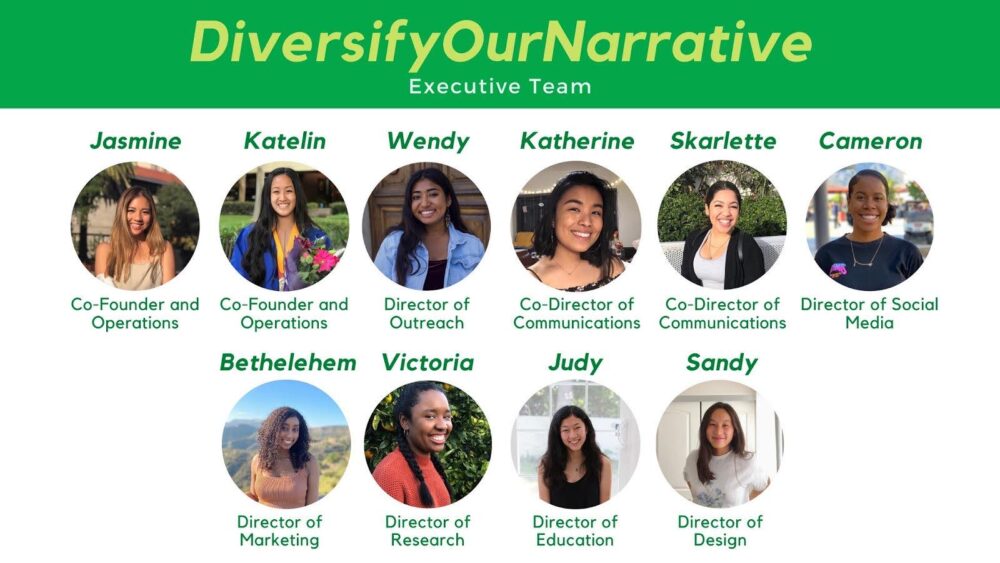
By Camelia Heins & Karen Phan
From New York to Minneapolis to Seattle, young people in the United States are making noise to create meaningful change amid increasing political, social and cultural turmoil fueled by the Black Lives Matter movement. California is no exception to that activist spirit — it’s home to the DiversifyOurNarrative (DON) initiative.
[Full disclosure: We are members of the Huntington Beach Union High School District (HBUHSD) chapter of DON; Camelia is a director of social media and Karen is a team coordinator.]
“[DON] is [a] grassroots, student-led campaign advocating for the inclusion of anti-racist and diverse texts in [California] high schools,” Jasmine Nguyen, a rising sophomore at Stanford University and the co-founder of DON, wrote in an email.
Nguyen and Katelin Zhou, fellow co-founder and Stanford sophomore, came up with the campaign while discussing current events on the phone one night. The two decided to bring the momentum of the Black Lives Matter movement to California’s high schools by forming DON in mid-June.
“Obviously racism has always been a huge problem for America…. but the momentum behind all the activism going on made us realize that there was a big opportunity to try and help contribute to the movement in whatever way we could,” Zhou wrote in an email. “I… realized that one of the potential ways we could address [race relations in America] was by teaching about these experiences in the classroom.”
So Nguyen and Zhou got to work. The first thing they did was research California’s education codes. Then they created a petition and got feedback on it by peers who were Black, Indigenous and people of color (BIPOC). To recruit members for their executive board, they reached out to their classmates at Stanford and former classmates from high school who had participated in Junior State of America, a non-partisan and student-led organization that promotes youth civic engagement.
“[T]he whole process from ideation to the launch of our website/social media only [took] about a week,” Zhou wrote.
At the forefront of DON is a call to California school boards to immediately adopt “at the very least one book about a BIPOC, written by a BIPOC per grade level in English classes,” Zhou wrote. Learning to be anti-racist, the DON petition argues, is just as important as learning math, science, English and history.
The campaign currently targets English classes because implementing diverse texts is a foot in the door to changing the rest of education, Zhou says. According to their petition, they target high schools because “it is the last time [students] will be enrolled in mandatory schooling.”
Led by 10 BIPOC women across California, DON also wants students to learn more about the ethnicities and cultures that make up the Golden State. Diversifying California’s narrative is key to empowering BIPOC students, said Victoria Gorum, a rising sophomore at Stanford University and the Director of Research of DON.
“My first quarter at Stanford, I took a class called ‘How to Make a Racist,’ where I learned about structural and interpersonal racism,” Gorum wrote in an email. “Having the opportunity to discuss race in a classroom setting opened my eyes to how deeply ingrained racism is in our society, and allowed me to further understand what it means for me to be a Black woman living in America.”
Gorum added that although her high school and college education have included the Black experience, they took “a very-one dimensional approach, meaning they tend to direct their focus only to the suffering of my community.”
“While it is important to acknowledge the damage that white America has done to people of color throughout the years, it is also important to study our accomplishments, literature, art, music and other aspects of our culture,” Gorum wrote. “My goal is to enable [BIPOC] students to feel heard, represented and proud of their people and their cultures in an academic setting.”
To turn their goals into reality, DON’s executive board works tirelessly with student organizers across the state to bring the initiative to the steps of their respective school boards. After a little less than a month, there are over 99 DON chapters, Zhou wrote. Over 1,000 student organizers are in the DON Slack channel, a platform that the executive board uses to communicate with and coordinate local chapter leaders.
“I have been blown away at how far we have come in the past few weeks,” Gorum wrote. “We have 15,000 plus signatures, a number of chapters and a few organizations reaching out to us for partnerships.”
The growing support DON and its individual chapters have received is impressive, but a push to change literary canon is certain to receive a push of opposition back. While a handful of chapters, such as those in Carpinteria and Los Angeles, have succeeded in presenting the campaign at their respective school board committees; other districts have not been as receptive to the movement.
“It can be challenging when there is severe pushback from certain school boards or community members, but the strength and resilience of our organizers most definitely inspires us to keep going,” Nguyen wrote.
Another challenge DON faces is that each school district across the state has different needs, and not all of these needs are adequately addressed in their petition.
“We try to provide our chapters with as many resources as possible and clear cut guides on how to lobby a school board, but the reality is each district is going to need their own unique approach,” Zhou wrote.
Nguyen and Zhou agree that the solution to uncooperative school districts or disapproval from educators, parents and students is being resilient and flexible. Gorum said that thinking about the positives rather than the negatives is what also pushes the executive team and student organizers forward.
“It’s incredibly rewarding to see so many people band together for a common cause,” Nguyen wrote.
DON’s influence has reached Southern California, too, establishing an Orange County presence with chapters in the Orange County School of Arts, the Garden Grove, Orange, Saddleback and Tustin Unified School Districts, and the Fullerton Joint and Huntington Beach Union High School Districts (HBUHSD).
With a team made up of eighteen members representing all six comprehensive high schools, DON HBUHSD has received over 1,000 petition signatures and gained over 400 followers on Instagram since it was founded on June 27.
“I think we’re on the right track and have made tremendous progress considering how [recently] the campaign was formed,” said Liana Le, a rising senior at Westminster High School and the co-director of social media for DON HBUHSD.
Le added that the HBUHSD chapter is working on a proposal of “feasible… requests” that remain true to the intentions of the parent petition for the 2020-2021 academic year. The proposal will be presented to the HBUHSD Board of Trustees at their meeting on Aug. 11.
“To solidify our proposal, we have contacted the English department from each site to give us feedback before presenting it to the school board,” Le said.
Aside from working on their proposal, DON HBUHSD has also taken to social media with a weekly series of history lessons called “Fact Check Friday,” and is working on raising money to purchase books.
The hard work that DON HBUHSD and hundreds of other students across California are putting into this initiative during their summer vacation is sure to create the first of many lasting changes.
The parent initiative’s more immediate plans include an expansion of DON nationwide, which they have been easing into this past week by creating petitions for each state. As for long-term goals, Nguyen said expanding DON to middle schools and to countries outside of the United States is a possibility.
“[W]e’re excited to see where this movement itself takes us,” Zhou wrote.
During a time of crisis and confusion, it’s refreshing and inspiring to see young students unite to make change in their local districts. DON’s momentum and calls for change prove they aren’t stopping anytime soon, at least not until their mission for a more inclusive and representative high school curriculum in California is fulfilled.
“In our increasingly diverse society, it is so incredibly important that students feel their lives are being reflected in literature,” Gorum wrote. “I hope this campaign inspires changes in our history books and broader curriculum structures. What we learn in school really influences how we view ourselves and others later on in life.”
Visit diversifyournarrative.com, @diversifyournarrative on Instagram or @TheDONCampaign on Twitter to learn more about the initiative. Visit DON HBUHSD’s Link Tree and their social media to learn more.





